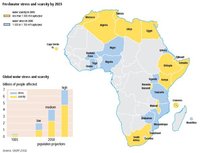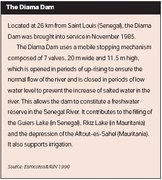Western Africa and freshwater resources
Contents
- 1 Introduction Western Africa’s water resources (Western Africa and freshwater resources) are characterized by extreme variability over both space and time. It is highly vulnerable to climate variability, as illustrated by the disastrous impact of drought over the past 30 years. The impact of drought is considered is associated with land use (Land resources in Africa). In some areas, there is a looming water crisis.
- 2 Endowments and opportunities
- 3 Challenges faced in realizing opportunities for development
- 4 Strategies to improve development opportunities
- 5 Further reading
Introduction Western Africa’s water resources (Western Africa and freshwater resources) are characterized by extreme variability over both space and time. It is highly vulnerable to climate variability, as illustrated by the disastrous impact of drought over the past 30 years. The impact of drought is considered is associated with land use (Land resources in Africa). In some areas, there is a looming water crisis.
The sub-region has six major internationally shared river basins. The three largest basins are those of the Niger, Volta and Senegal rivers. These freshwater resources are unevenly distributed between countries. Temporal variation in rainfall is common, but only the countries in the northern Sahelian zone regularly experience drought, while floods periodically affect countries in the wetter coastal belt. Groundwater mainly occurs in basement, coastal and Sahelian sedimentary aquifers. The availability of groundwater varies considerably from one type of hydrogeological domain to another, depending on the local levels of precipitation and infiltration, which determine the actual recharge. In Mauritania, for example, internal renewable groundwater resources are estimated at 0.3 km3 per year and these are important sources of water for domestic use, irrigation and livestock watering.
Endowments and opportunities
Wetland ecosystems and their resources are diverse, including inland water resources with abundant fisheries. These resources provide food supply and income to many communities. For example, the Niger River system sustains biological communities which include 250 species of freshwater fish, of which 20 are not found anywhere else.
Specialized flora have developed in the floodplains and delta to cope with extreme fluctuations in water level. There is great opportunity for the expansion of irrigated agriculture. The Senegal River has a maximum irrigation potential of 420,000 hectares (ha), of which only 118,000 ha is under irrigation. The Diama Dam offers irrigation opportunities of 240,000 ha. The Niger River is Africa’s second longest river at 4,100 kilometers (km), and the basin covers 1,471,000 km2; this amounts to 7.25 percent of the total area of the African continent. The irrigation potential of the Niger River is vast:
- In Guinea it could support 185,000 ha (only 6,000 is under irrigation);
- In Côte d’Ivoire it could support 50,000 ha;
- In Mali it could support 556,000 ha (only 130,000 is under irrigation);
- In Burkina Faso it could support 5000 ha (only 850 is under irrigation);
- In Benin it could support 100,000 ha; and
- In Niger it could support 140,000 ha.
Due to insufficient investment and operational funds for water supply systems and irrigation infrastructure, unaccounted-for water for Africa as a whole is often between 40 and 60 percent. Exceptions are Abidjan in Côte d’Ivoire and Conakry in Guinea, where unaccounted-for water has been reduced to about 25 percent. In Lomé (Togo), the public water utility has made major improvements, with losses now down to only 20 percent, most water bills paid and water subsidies no longer required. Another challenge is to protect the environment. Progress has been made in this regard through public education and awareness.
Challenges faced in realizing opportunities for development
 Figure 2: Freshwater stress and scarcity by 2025. (Source: UNEP 2002)
Figure 2: Freshwater stress and scarcity by 2025. (Source: UNEP 2002) Of the 16 Western African countries, two, Burkina Faso and Nigeria, currently experience water stress and by 2025 this is expected to rise to five. Climate change (Climate change and development challenges in Africa) is expected to bring about reduced rainfall and increased evaporation in the areas to the north, thus advancing the rate of desertification (Land degradation and desertification in Africa) in the Sahel. Combined with existing high rates of deforestation and degradation of vegetation cover, this could have serious consequences for soil erosion and agricultural (Agriculture and development in Africa) activity. There is growing concern about pollution of water resources. This is particularly the case in the Niger delta in Nigeria, with the frequent spillage from oil production and distribution. Population growth and development are further threatening the Niger River’s ability to supply crucially needed natural resources to the people of West Africa. River flows in the basin are decreasing at the same time that fishing pressure is increasing, leading to drastic declines in the productivity of the Niger’s fisheries.
Strategies to improve development opportunities
 Reform in Nigeria's River Basin-Development Authorities in favor of the rural communities. (Source: World Bank 2000)
Reform in Nigeria's River Basin-Development Authorities in favor of the rural communities. (Source: World Bank 2000) In the light of the major issues identified, the countries have responded by initiating water sector strategies and reforms at national and transboundary levels. At national level, water sector reforms include:
- Establishing new institutions to improve the coordination of water resources development and management. Water departments were upgraded or converted into public agencies to operate along commercial lines;
- Reorganizing institutions in the water supply, sanitation and irrigation sectors to improve their efficiency; and
- Revisiting the legal framework to create a common approach for water laws as well as to break the state monopoly on water supply and promote competition.
Major challenges for water resource management (Governance of water resources in Africa) are to decentralize and devolve responsibilities to the lowest appropriate level, increase investment in the water sector infrastructure, attain cost-recovery, and to provide adequate institutional and legal capacity. Reforms are currently being implemented in Nigeria’s River Basin Development Authorities (RBDA) to address the involvement of marginalized communities in the these structures.
At transboundary level, water sector reforms of basin organizations (Niger Basin Authority, Senegal River Basin Organization and Lake Chad Basin Commission) included the review of their focus, functions, financing, structure, leadership and secretariat. Efforts are being made to revive the war-torn Mano River Union and to promote the set-up of new river basin organizations, such as for the Volta River basin. The water sector reforms, however, have been constrained in many countries by various factors, among which are internal resistance from executives of institutions, the lack of political will, political instability or frequent changes in government, and dependence on development partners to find the resources for reforms. Despite these constraints, the Senegal River Basin Organization has been successful in achieving tangible development goals, particularly in the hydropower subsector.
Opportunities have been created to face the challenges, such as the Regional Action Plan for integrated water resources management (IWRM) (2000-2004) and a project for the creation of a permanent structure for the coordination and monitoring of (IWRM). In 2002, the African Network of Basin Organizations (ANBO) was established which constitutes an opportunity for basin organizations and authorities to cooperate with international partners in the implementation of their programs. As such, ANBO could mobilize solidarity for the achievement of the MDGs. Opportunities for capacity-building exist, for example through WA-Net at the University of Cape Coast (Ghana) and the Water Resources Institute in Kaduna (Nigeria). To date, WA-Net has significantly contributed to the Western African African capacity-building endeavor in the water sector.
Governments’ recognition that water is not only a social but also an economic and environmental good is reflected in economic and environmental reforms. These reforms have seen the removal of government subsidies on prices of commodities and services, and the encouragement of private-sector participation.
There has been improvement in funding the water supply subsector by establishing modalities for mobilizing investment funds from governments, beneficiaries and donors. Mechanisms have also been established for cost-recovery through water tariffs that take into account the costs of investment, operation, maintenance, system expansion and renewal. An innovative approach adopted by the city of Conakry, Guinea, involves the private sector in urban water supply with the aim to improve services.
More opportunities exist for small water supply and sanitation service provision because of the significant market size and very low market penetration. It is estimated that market penetration is only 7 percent of all poor households in Western Africa.
Further reading
- AfDB and ADF, 2000. Policy for Integrated Water Resources Management. African Development Bank and African Development Fund.
- Briscoe, J. 2000. The World Bank’s role in Water Resources Management in Nigeria and its implications for the Bank’s Water Resources Sector Strategy: Results of a consultation. The World Bank/International Finance Corporation/Multilateral Investment Guarantee Agency. Office Memorandum, 14 October.
- ECA, 2000. Transboundary River/Lake Basin Water Development in Africa: Prospects, Problems, and Achievements. ECA/RCID/052/00. United Nations Economic Commission for Africa, Addis Ababa.
- FAO, 1997. Irrigation Potential in Africa: A Basin Approach. Food and Agriculture Organization of the United Nations, Rome. FAO Land and Water Bulletin 4.
- IPCC, 2001. Climate Change 2001: Synthesis Report. A Contribution of Working Groups I, II, and III to the Third Assessment Report of the Intergovernmental Panel on Climate Change (eds. Watson, R.T. and the Core Writing Team). Cambridge University Press, Cambridge. ISBN: 0521807700
- Mehta, M. and Virjee, K., 2003. Financing Small Water-supply and Sanitation Service Providers: Exploring the Micro finance Option in sub-Saharan Africa. Water and Sanitation Programme, Nairobi.
- NEPAD, 2003. Action Plan for the Environment Initiative. New Partnership for Africa’s Development, Midrand.
- UNEP, 2006. Africa Environment Outlook 2
- WRI, 2000. World Resources 2000-2001: People and ecosystems: The fraying web of life. ISBN: 1569734437
- WWF, 2002. West Africa takes a leap forward for freshwater conservation. Press Release, 16 February.
|
|
| Disclaimer: This article is taken wholly from, or contains information that was originally published by, the United Nations Environment Programme. Topic editors and authors for the Encyclopedia of Earth may have edited its content or added new information. The use of information from the United Nations Environment Programme should not be construed as support for or endorsement by that organization for any new information added by EoE personnel, or for any editing of the original content. |

